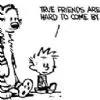well, as many of us wer left pondering abt the Suhasinis Triya Charita (mis) advice.. i googled it and came up with the following..
The perception of women as unruly, threatening, and shameless was in India encapsulated in a catchphrase,
stri charitra or
triya charitra . Literally this expression translates as the "moral nature" or "character" (
charitra ) of women (
stri, triya ). By extension
charitra means "narrative" or "biography," and so the phrase could also be translated as "the woman's story" or even "hasty." In popular Indian parlance, however, the phrase has a decidedly misogynist ring, more equivalent to "female trouble" or "women's wiles."
Triya charitra became a prevalent folklore theme in North India, one illustrated by a number of stories. They are preoccupied with the potential infidelity of the young wife. Continuing in their mold, it pictures a woman who is deceptive, sexually voracious, murderous, and beyond redemption.
--apart from such stories being popularized as fables.. it also finds place in a religious book.. Guru Granth Sahib.. tho they have been put there as moral stories.. and are Charitaropakhyan... Charitaropakhyan means those tales which were already told by someone, which means the tales consisting in this bani were already told in history.
Triya Charitar: Triya Charitar are those TRIYA CHARITARS, where characters are female. The aim of these charitar was to guide that even female's mind can be Manmat (self or ego driven) and she can play such wrong charitar to satisfy her rage.
Charitars arise from foreign sources, personal experiences of the Tenth Guru and others miscellaneous sources. Many scandalous stories floating about the society of the time, imaginary stories, urban legends etc., also found their way into Triya Chritar.
"The Charitar acts as a warning so that the devout do not get trapped in women's intrigues and machinations.''
The moral they aim at is that one should not become entangled in the intrigues of wily women by becoming a slave to lust, for trusting them is dangerous. This does not mean that it is wrong to trust one's own wife, or worthy women; but that it is fatal to lose this world and the next by becoming enamoured of strange women and entrapped in their wiles.
The theme of most of the tales, however, is that many women will stop at nothing; slander, arson, even murder to obtain their heart's desire; that men are helpless in their clutches; and that if men spurn them they have to reckon with the vilest and deadliest of enemies; but that, conversely, worthy women are the staunchest of allies, and think nothing of sacrificing their lives for their beloved.
--Well, this is most interesting.. tho i have never even read or heard obt these fables.. may b its more common in Northern India...
It is mentioned tho in Ramayana.. wer in Manthra incites Kaikayi to persuade king Dasratha to exile Ram using her triya charitra.. i.e. feminine wiles a la deceiving tricks... 😆
well it does seem.. tht Suhasini is acting as Manthra here.. and Mallu Kaikayi to fasao.. RAja Dashrath aka.. Ashu to exile Nidhi 🤣
Edited by achiever - 13 years ago




































